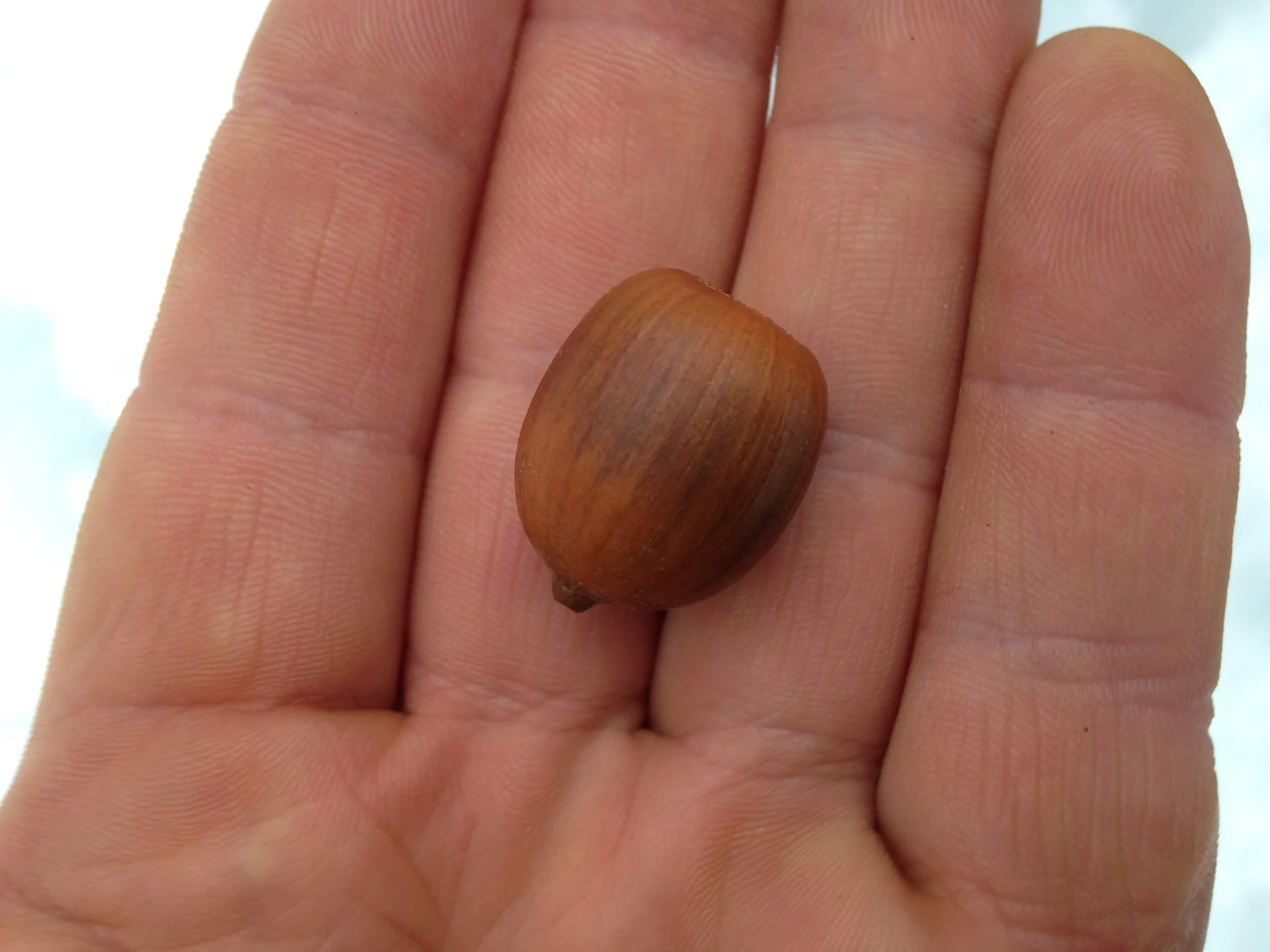Follow The Food
Fri, Feb 11 Conditions at Dwight, Ontario : high of 1*C; low of -3*C; precip 7mm; wind coming from the South, max wind 33km/h; overcast.
On Friday afternoon shortly after we arrived at the cottage in the Lake of Bays district where we were spending the weekend, four of us decided to go for a hike. We slowly made our way up a steep East facing hill through the deep snow (~90 cm / 35⅞ in). We were following some older snowed-in White-tailed Deer (Odocoileus virginianus) trails which were weaving in and out of each other generally going higher and higher up the hillside. It was fun to look back down into the valley and see how high we were getting in such a short period, but I kept getting distracted by areas in the snow which had been dug out by the deer. They weren’t beds as they we way to0 wide, too long, too deep, and ragged looking around the edges. When the three other folks I was with began heading down into a small ravine I ended up taking my time in one of the dug out spots to see if I could figure anything out about their purpose. Through investigating at the base of one of the dug outs I found pieces of a fern, some where only the stalk remained, some with pieces of the leaflets, and many of the remaining stalks had been obviously browsed by the deer.
This was interesting to me because I had heard before that if you come across a forest floor that is littered with ferns and not much else in the sense of understory forbs then you are likely encountering a forest with a large population of deer. I had heard that this was because deer do not like to eat ferns. But here I was finding ferns that had been grazed by the deer and I got to wondering. Was this just an emergency food for the depths of winter when not much else was available? Was this even the deer grazing, could it have been another animal? What kind of fern was this? I took a lot of photographs and hoped that I could look into it later, and finally, later has arrived.
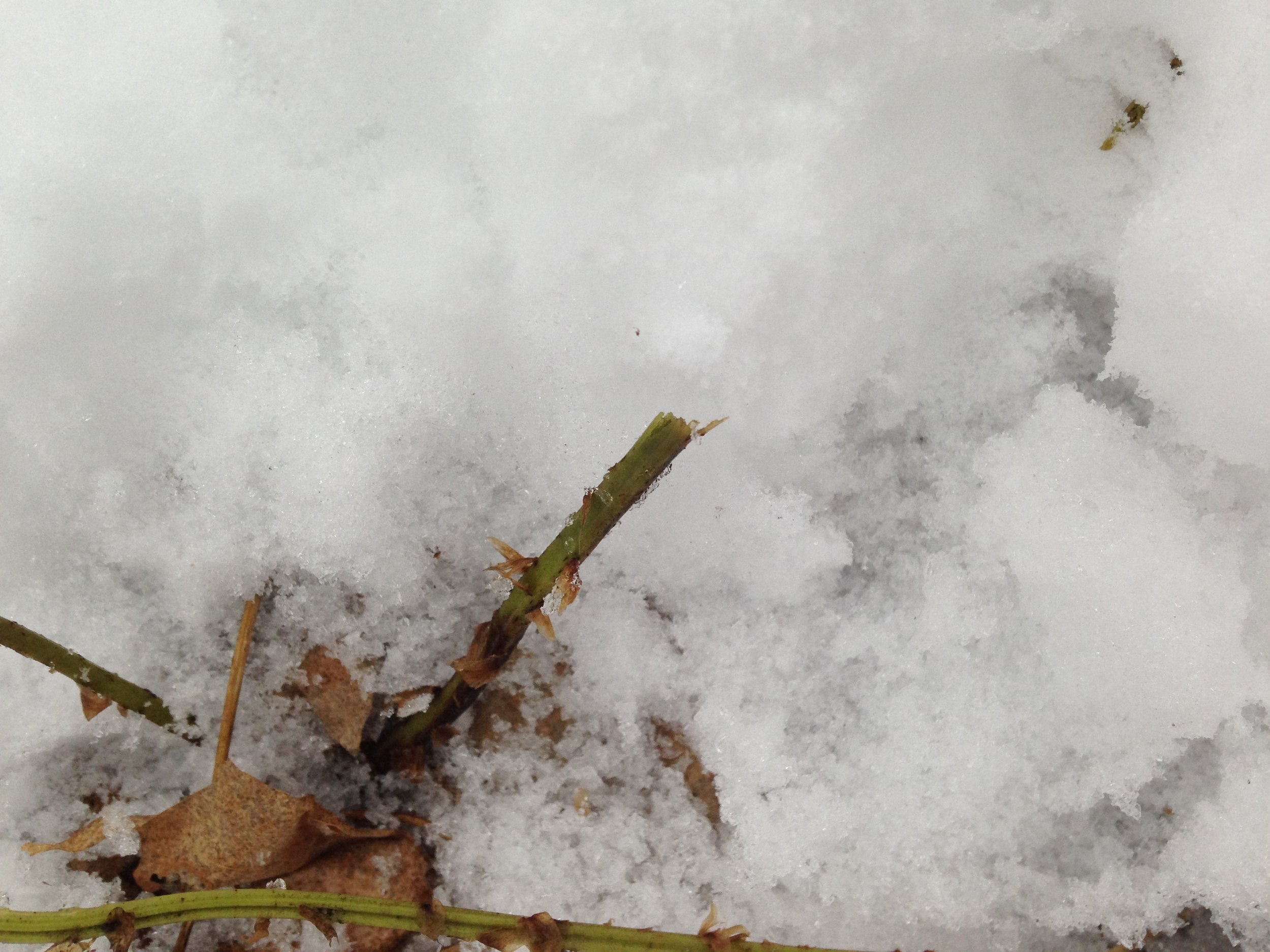
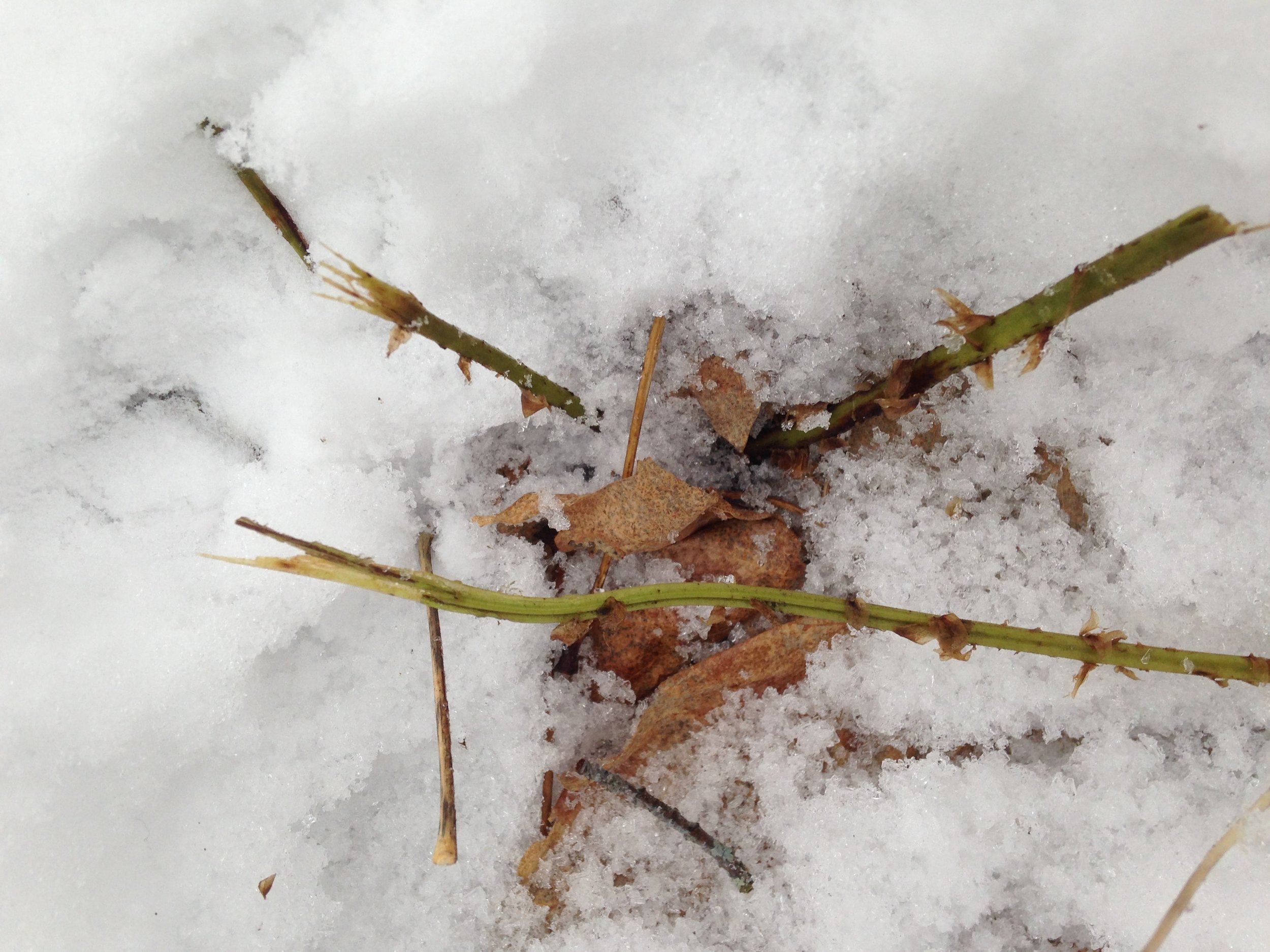
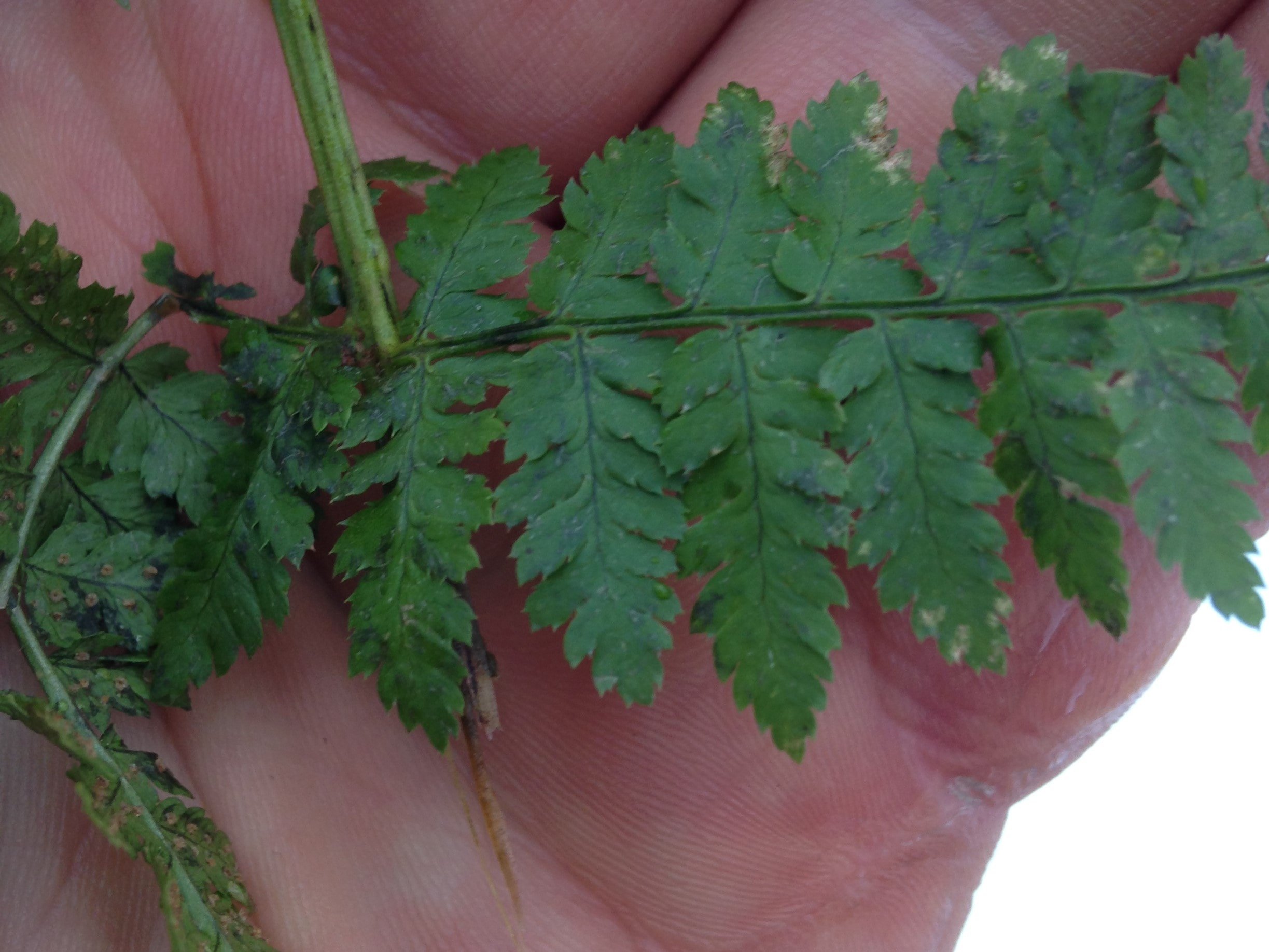
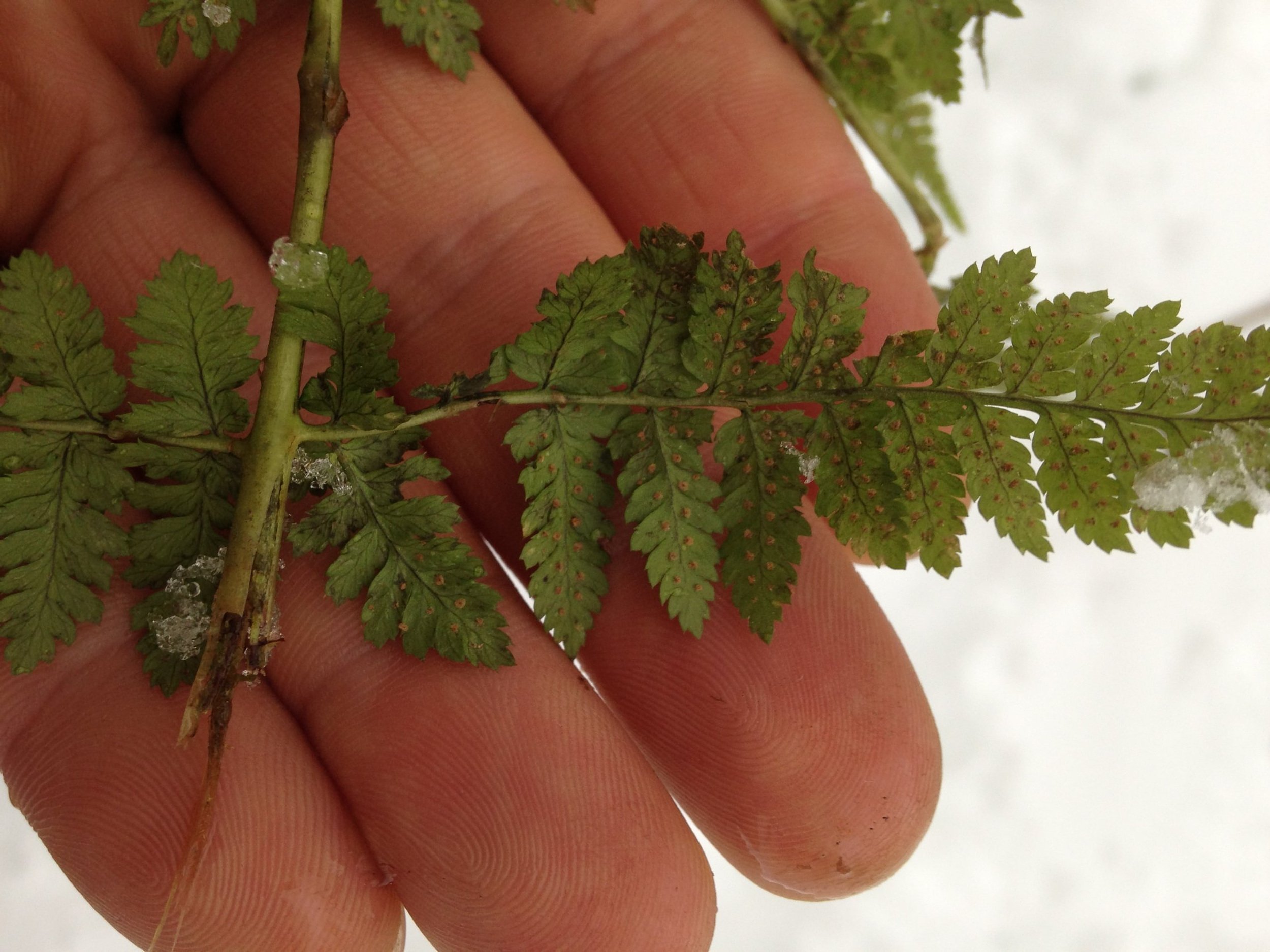
It turns out that there are relatively few absolutely deer-proof plants. If the winters are hard enough, the deer will eat anything, ferns included. But hearing from folks who knew the area pretty well, this year has not been an exceptionally hard winter for the deer. In fact, the forest around us was dominated by Sugar Maples (Acer saccharum), American Beech (Fagus grandifolia), and Red Oak (Quercus rubra) with plenty of Eastern Hemlock (Tsuga canadensis) stands interspersed. This implies there is likely a lot of choice food in the area for the deer to find beneath the snow. But was it even the deer who were munching on the ferns anyways? Was it a lagomorph or rodent of some kind?
When I look at the tip of the stalks where the ends were a bit ragged and a little frayed, this discounted possible consumption by lagomorphs and rodents who typically slice the plants with their tops and bottom incisors, often leaving a clean angled cut, though not always. White-tailed Deer however only have bottom incisors and a hard palate on top. When they reach for a stalk to eat they hold the stalk between their lower incisors and their hard palate and pull, leaving a flat but rough and ragged edge, similar to what is seen in the photos above. Also, while there were many deer tracks around, there were no lagomorph or rodent tracks to be found. This points to the deer.
Now, a tricky question... What kind of fern was it anyways? I do not know my ferns very well and could only probably identify four or five ferns, all of whom are distinct in features and usually also in habitat. This habitat I was only seeing in the midst of winter with about 60 cm (24 in) of snow on the ground. I had to look close for features I was learning to look for. I noticed that the frond had been divided three times, and there was a shallow groove along the stipe (stalk below the blade) and rachis (the stalk within the blade), similar though not as deep or wide as the groove on the more familiar Ostrich Fern (Matteuccia struthiopteris). Looking into the books I have at my disposal (A Guide to the Ferns of Grey and Bruce Counties, 1999 and Michigan Ferns & Lycophytes, 2018, and Peterson Field Guide to Ferns, 1956) I am coming to the conclusion that this is a species in the Dryopteris genus, otherwise known as Wood Ferns, but I am uncertain of species, though I am leaning towards D. intermedia. Really, there was only so much of the fern showing from under the snow, and I am still learning fern id. To make things harder I have read that some of the Dryopteris species tend to hybridize! In my searching online I have found a couple of places which mention that White-tailed Deer will consume some of the Wood Ferns, especially Dryopteris intermedia in harder winters.
I ended up packing a sample of the fern into my notebook and heading down the snowy hill to meet up with my colleagues who were investigating another patch of forest floor that had the snow shuffled and leafy debris scattered atop. As I got in range, Maddie tossed me an acorn. As I held it and looked close I heard the others describing the scene as they were seeing it. I was trying to remember which of the oaks had more tannic acid and which had less fat? And why do they have the tannins in the first place?
Red Oak (Quercus rubra) acorn.
My research concludes that tannic acid protects proteins and prevents them from rot. I have been on the search for good leather winter mitts lately and have been thinking of how tannins protect the proteins in the leather by preventing them from breaking down. Same thing works with the acorns. Tannins help keep the acorn from spoiling before they have a chance to sprout. Some oaks take longer to sprout, while some are shorter. White Oaks (Quercus alba), a species and a loose grouping of species with some similar characteristics like rounded lobes on the leaves for one, produce acorns with less tannin content. Since these acorns germinate in the Fall, they do not need to resist bacteria and fungi as much before they sprout so they only need a little protection. Red Oaks, another individual species and informal grouping of characteristics (botany can be confusing), germinate in the Spring. That means they need more protection over the long winter, and that comes from more tannins. These tannins keep the acorns free of pathogens but also keep them safer from predation by wildlife. Deer tend to avoid the Red Oak acorns while there are milder, not as astringent or bitter tasting White Oak acorns around. But once those White acorns run out, or access to them changes, then the deer will take what they can get. It seemed like presently, it was the Red Oak acorns.
We slowly made our way up a new hill, this one now facing the West. This new hill still had lots of snow, but it seemed like there was less especially as we edged around a small copse of Eastern Hemlocks. Tom Wessels (Reading the Forested Landscape, 1997) writes that Hemlocks have the highest tolerance for shade in the New England region which is similar latitude and climactic conditions to Lake of Bays where we were tracking, and John Eastman (The Book of Forest and Thicket, 1992) writes that the Eastern Hemlock also casts the densest shade in the forest, not only because of the thick foliage, but also because “conifer canopies tend to filter out light across the entire spectrum. They therefore cast “blue shade” (in contrast to “green shade” of broadleaf trees, which reflect the green portion of the spectrum).” If you think of the shade they provide, it is also understandable to think of how the dense foliage can also produce a ton of cover. I have read and observed that the deer tend to bed nearby if not directly below Hemlocks as they tend to hold the snow within the branches. These branches also make for good cover for Wild Turkeys (Meleagris gallopavo) and Ruffed Grouse (Bonasa umbellus). As for food, White-tailed Deer, Porcupine (Erethizon dorsatum), Red Squirrel (Tamiasciurus hudsonicus), Ruffed Grouse, Black-capped Chickadee (Poecile atricapillus), Pine Siskin (Spinus pinus), Crossbills (Loxia spp.)and many others eat Hemlock leaves, buds, seeds, or bark.
We stopped for a moment to discuss something, which I can’t really remember anyways. I do remember that I was facing the Hemlocks and other folks were facing me. I can’t even remember who was talking when I saw some small movement on the other side of the Hemlocks and I quickly, quietly pointed and said “Deer.”
I was so grateful for the crew I was with. Everyone knew right away to be freeze and be silent. It felt like everyone stopped so quickly and everything about us emptied and were open to what might happen. A sacred stillness and quiet filled us and we stood and strained at first to see the deer emerge from beyond the trees at the far side of the copse. One, three, five, then maybe 6 or 7 appeared. We just watched. The wind was coming from the South and we happened to be downwind of the deer so it was tricky for them to smell us. Somehow, they became aware we were there, though it must have been uncertain because that was when one them stamped their front right hoof. This stamping action usually implies that there is a possible danger nearby but there is some uncertainty of what it might be, and how dangerous this unknown is. It means the deer are on alert, but that there is no immediate need to expend the energy required to run. For us it meant be cautious, move really slow, keep a positive loving “vibe” in our hearts and minds, and be quiet. Were we imposing on the deer? Were we causing unnecessary stress during the hardest time of the year? I wondered this quietly to myself and watched closely for any signs of stress or discomfort and trusted that the deer who outnumbered, and could definitely out maneuver us, would move if they so chose.
After a while I noticed one of the deer bending low and looking over the snow as if grazing but never really eating anything. It seemed as if they were keeping their eyes, ears and noses on us but also feigning a baseline. I felt as if this was a strategy of inquiry. Of course it’s odd to put ourselves and our minds onto the minds of other animals and to anthropomorphize, but I do like to try and allow the minds of other animals to make their way into my own, to imagine what their sense of the world is, what they might desire and fear and to let that impress itself on me. I can then practice looking at the world through the points of reference as I might imagine a deer would. I can imagine being White-tailed Deer in mid-February on a snowy hill top looking across a Hemlock copse at a blurry row of humans wondering what they were up to out in these woods. I can “become” deer for a moment. In that I decided to practice being deer.
I can’t remember who first mentioned it, maybe my friend Adrian, or maybe it was a random conversation, but it struck me long ago as a good idea to mimic the baseline behaviours of animals when you come to encounter them. I had done this before with deer and the deer not only hung out for a while, but came over to investigate us, twice! I have also done this with an Eastern Chipmunk (Tamias striatus), and practiced collecting and eating Eastern White Cedar (Thuja occidentalis) seeds alongside them for a few minutes. In the context which I am telling the story of, I ended up visibly bending down and pawing at the snow with my mitt, adopting the pace and cadence of the deer throughout the experiment. I worried that I might spook the group, and alienate my own friends if the deer ran off at my sudden movements. Instead of escape, one of the deer came in closer! I waited and after a while they bowed and explored the snow. They waited and I did the same. I noticed that after a few of these bows and fake feeding actions, one of my companions began doing the same. I think we all sensed that this was a back and forth between us and the deer and eventually I think everyone in our group was slowly practicing being deer. The deer themselves seemed undisturbed and perhaps more relaxed at this more familiar behaviour.
This experience, which wasn’t adversarial so I can’t call it a stand off, but instead maybe an investigation of each other, was forever in a moment and allowed for lots of questions to come up and lots of chances for experimentation. I remembered worrying about our scent if the wind changed direction. I bent down again and this time picked up a twig of Hemlock and began eating it, accentuating the sound of my chewing, and exhaling the scent.
My group eventually started moving a step or two closer as the deer stepped a little closer. All of this in incredible silence and slowness which typified the entire encounter. It was only when a howl rang out from the South West that everyone stopped and looked towards the place where the sound was coming from, freezing and listening for a second. The deer seemed to moved in unison, with all turning and moving uphill a few paces, and we following their lead also moved uphill, and closed the gap between the two groups. We hadn’t gone far at all when the deer stopped and we stopped as well. Maybe it was at this point that some of the deer continued on over the hill and only a few stragglers remained. I look back at the photos I took and realize that it had already been about 45 minutes since encountering the deer. At this point we were between 15 - 20 m (50 - 65 ft) away from the deer when the slowly the rest of them turned and left. We gathered slowly to share in what we saw, to sort out how many deer there were, and who did what when? There were insights and questions and excitement and awe. It felt magical and very grounding to be a part and also apart. We moved towards where the deer were just standing, watching us. We bent down and smelled the patch of urine left behind. It smelt surprisingly of butter and fruit. Was this the fattiness of the acorns and the fruitiness of the Hemlock? I wasn’t sure but I was excited.
We were all pretty excited stepping high through the deep snow heading back towards the cottage we were staying at the bottom of the hill. I can’t remember who noticed it first, but there was a bit of scat, urine, tracks and some other impressions at the bottom of another Hemlock tree.

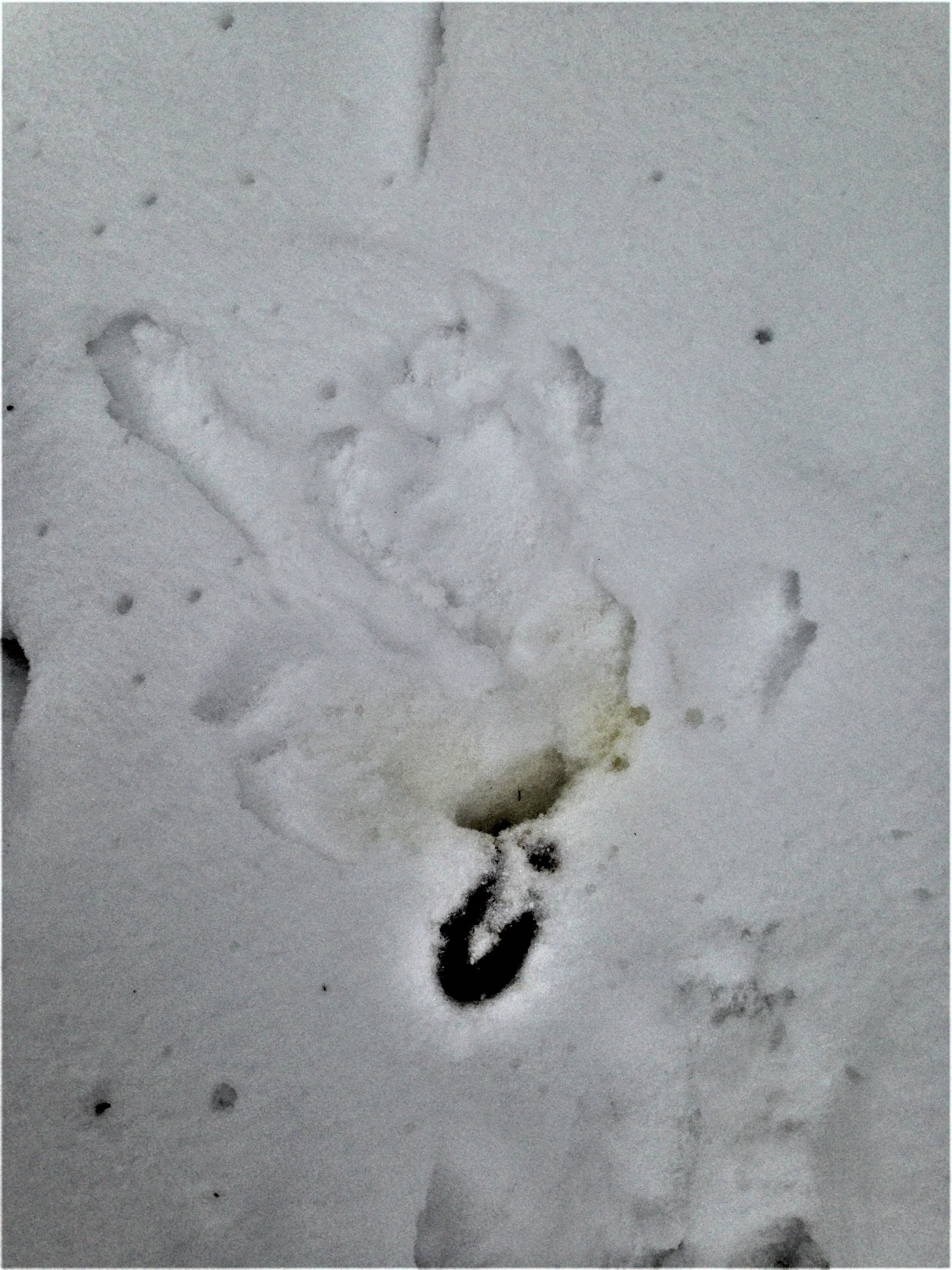
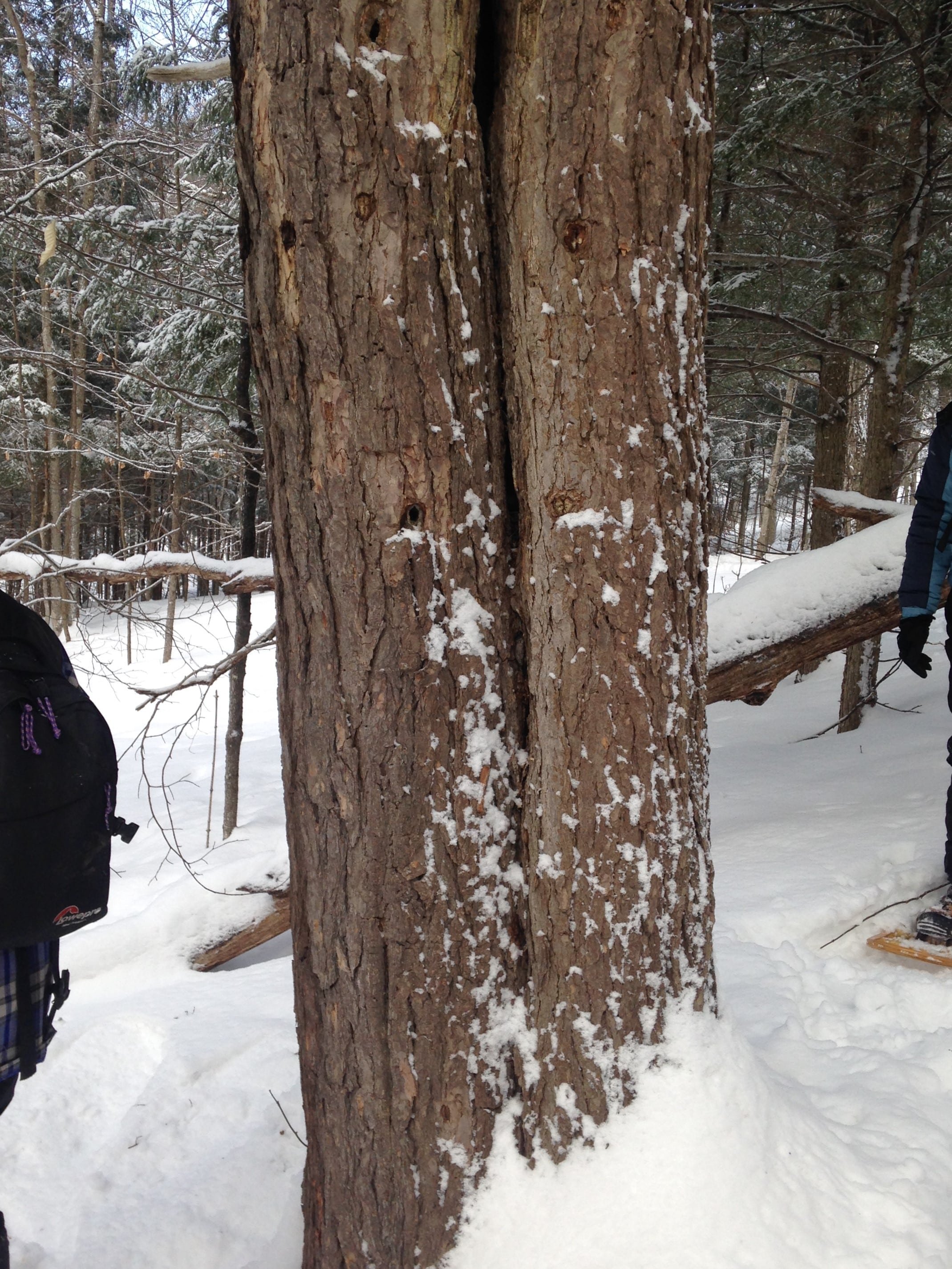
I remember looking down at the scat and wondering about who might have left it there. I noticed the tapered ends and that it was kind of long. When I measured the scat it was 9.5 cm (3¾ in) long x 1 cm (⅜ in) in diameter. There was also a fairly clear imprint of a foot (middle right) which appeared to have 5 toes but was much wider than a squirrel. Another animal with a wide foot with five toes is a Snowshoe Hare (Lepus americanus) but I saw none of their tracks leading up to this set, nor away from them. I stood up and leaned against the tree while considering the possibility of a Marten (Martes americana) when I heard a quiet growl some where to my left. I froze for a moment and then heard another one. That was when I jumped back nearly stumbling over myself in the deep snow. I think everyone noticed the growling at the same time and we all sorted it out very quickly that it was coming from the Hemlock tree. I scrambled up to the side of the tree and pulled out the audio recorder and began recording the frustrated animal.
We all seemed to agree that it was likely a Marten hiding in the tree. My reading has named many different vocalizations used in different contexts. Mark Elbroch and Kurt Rinehart describe Marten vocalizations in their book Behaviour of North American Mammals (2011) :
Because martens [sic] and fishers are so difficult to observe in the wild, descriptive records of their vocalizations mostly reflect defensive or agonistic circumstances during capture and handling for research. Calls that have been noted during capture and handling of martens include huffs, pants, chuckles, growls, screams and whines. Martens huff in a rapid, accentuated exhalation, and “pant” in a series of less forceful huffs. The huff sounds somewhat similar to the hiss of a weasel and most likely expresses a low level of fear or unease. “Chuckles” are rapid bursts of sound that can be deep and throaty and interspersed with other rhythms and other sounds, including growls. Martens make a growl, and when in terror or pain they utter a high, prolonged scream.
Later on I was wondering about the growl and if the Marten would growl at prey as predators are often portrayed doing in films. I think that that is really unlikely as a predator would be thinking of stealth and not trying to draw any attention to themselves. This got me wondering what exactly Martens eat? I brought it up with my mentor Alexis the next day when we returned to the same spot to further investigate. I recalled some scat we had found a few years back from a Marten full of Aralia seeds, but I was really wondering what else this larger member of the Weasel family likes to eat? In true Weasel family style, here is a short list of the things a Marten might eat: Snowshoe Hare, squirrels, mice and voles, carrion, bird eggs, birds up to the size of a Grouse, amphibians, snakes, insects, earthworms, fish, and fruit and nuts in season. So, a lot of everything, as long as the animal is small enough.
I decided for myself that it was time to leave the animal alone. I was already feeling a pang of worry that we had imposed too much on the deer and now this creature cornered in the hollowed trunk of a tree sounded right peeved that we were so close. I skipped down the hillside landing in deep snow, full of excitement and wonder and joy when before me, at the bottom were four deer, likely members of the crew we had encountered just minutes before. I stopped and spoke to them letting them know I was coming down the hill and would take the long way around, and before I finished they were already bounding their ways up the hill and away. My face probably looked bright red at this point due to elation, exertion, and cold. But I was beaming on the inside and stoked for the weekend to come.
To learn more :
Grey Squirrel Food Preferences: The Effects of Tannin and Fat Concentration
Squirrels, Acorns and Tannins
The Pine Marten is Nature's Most Adorable Assassin! - listen close for the growls. Different context, but very similar.


